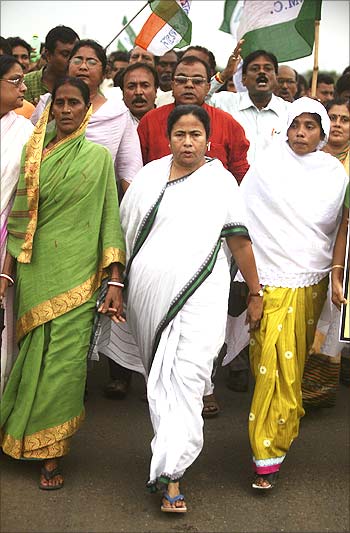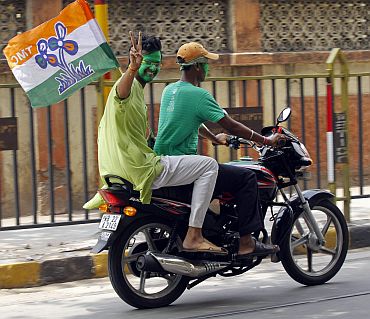Mamata Banerjee gave Bengal the revolution it wanted but people will want to see results soon, says Aditi Phadnis
It is now more than a month since Mamata Banerjee and her Trinamool Congress-Congress alliance government assumed power in West Bengal.
What has the government achieved and where is the state going?
No one said Bengal would have an easy time of it when she took over. Apart from her own -- for the lack of a better word, foibles -- the collective lack of administrative experience of her colleagues and the political compulsion of producing quick results, Banerjee has also had to contend with the highly politicised middle bureaucracy in the state and its proven aversion to work.
So she decided to rule by example, setting a scorching pace for herself -- a 15- to 18-hour day, punctuated by surprise visits to state-run hospitals (where she had a run-in with one of the medical superintendents who made public his resentment at having to drop everything he was doing and address her questions), a fast turnover of administrative decisions (that turned out to be riddled with infirmities) and at least one "peace agreement" with the Gorkhas in Darjeeling (also judged unstable).
Trinamool Congress workers behaving like CPI-M men
Then there's been the challenge of preventing Trinamool Congress workers from behaving in exactly the same way as their predecessors from the Communist Party of India -- Marxist.
Trinamool workers have been enforcing "fines" on CPI-M functionaries and the CPI-M has lost at least 18 people in the last one month as a result of political clashes. The police are reluctant to intervene for obvious reasons.
However, given that the former chief secretary of West Bengal is now a minister in the government, the biggest scandal has been the bumbling journey of the ordinance that wasn't.
The protests of peasants in Singur whose land was taken away, allegedly forcibly, by the Left Front government propelled the Trinamool Congress to victory. So at the very first meeting of the cabinet, the government resolved that the land of peasants in Singur would be returned to them.
Singur Bill full of legal loopholes
But why issue an ordinance to this effect when the assembly was in session? Wouldn't a resolution in the assembly (where the government has a more than convincing majority) have been more binding?
West Bengal Governor M K Narayanan asked some questions and was given to understand that there was no impropriety in issuing an ordinance when the House was in session. However, within hours, the governor realised he'd made a mistake, recalled the ordinance and cancelled it.
That wasn't the end of the story. The government introduced the cabinet resolution as a Bill in the assembly. It was passed after a routine two-hour debate. But the Bill was drafted in a hurry and the new law had so many legal loopholes that it has now been challenged in court -- not just by industry but by groups of farmers as well.
With all the resources at their command, corporate houses like the Tatas can afford to wait and fight for justice. But can the farmers of Singur? All because of the incompetence of a state government that is supposedly fighting on their behalf?
Banerjee has to find land for peasants
The issue of land continues to be a problem. Burdwan has seen two movements to resist land acquisition -- one against the Health City project (which incidentally was started by the Left Front regime, proving once again that a woman can, in fact, also think like a man); and the other against the Eastern Coalfields Limited that is trying to set up new open cast coal mines in the district, on land acquired from 30,000 villagers. Ironically, the CPI-M is leading the protests.
Banerjee is not just faced with the problem of peasants losing land. She also has to find land to give to peasants.
In the footsteps of the CPI-M, which leveraged land reform with such success to stay in power for three decades, Banerjee announced in her manifesto that she would acquire land and redistribute it to the homeless.
The price tag? Nobody knows.
A committee headed by former IAS officer Debabrata Bandopadhyaya had recommended that Rs 1,500 crore be allotted to give land to 550,000 people (declared homeless as enumerated by the National Sample Survey Organisation) over the next five years. This hardly seems sufficient because the cost of the land the government will have to buy is much higher than the rates it has fixed for itself. And then, the basic question: What about the money? Where will it come from?
People of Bengal want to see the results
Banerjee reached an agreement with the Gorkha Janamukti Morcha that promised to drop its agitation for a separate Gorkhaland state in the Darjeeling hills in return for certain assurances. Now the GJM's rivals have started a movement charging the GJM with having sold out.
Banerjee's initiative to attract investment to West Bengal was the creation of a single-window committee to address the problems of industry. Guess how many people the single window has? 25 to 28 secretaries.
The thing is, people like revolutions. But they also want, after a revolution, to see results. Banerjee has delivered a revolution. But the people are going to get very angry if they feel all they've got for their efforts is incompetence.






article